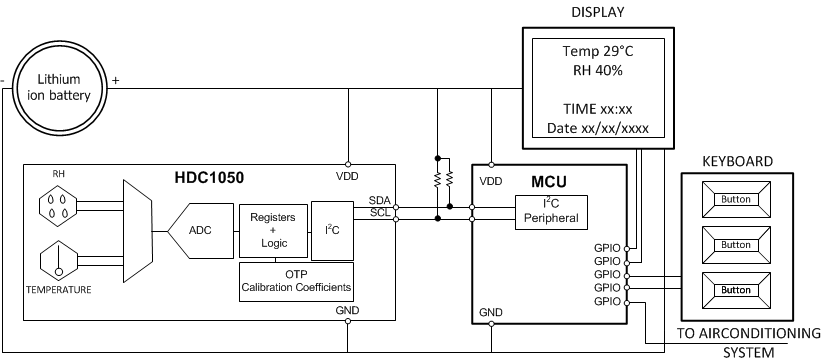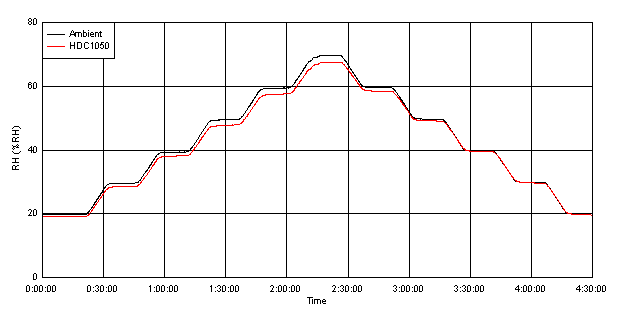ZHCSDX0B May 2015 – July 2015 HDC1050
PRODUCTION DATA.
- 1 特性
- 2 应用
- 3 说明
- 4 典型应用
- 5 修订历史记录
- 6 Pin Configuration and Functions
- 7 Specifications
- 8 Detailed Description
- 9 Application and Implementation
- 10Power Supply Recommendations
- 11Layout
- 12器件和文档支持
- 13机械、封装和可订购信息
9 Application and Implementation
NOTE
Information in the following applications sections is not part of the TI component specification, and TI does not warrant its accuracy or completeness. TI’s customers are responsible for determining suitability of components for their purposes. Customers should validate and test their design implementation to confirm system functionality.
9.1 Application Information
An HVAC system thermostat control is based on environmental sensors and a micro-controller. The microcontroller acquires data from humidity sensors and temperature sensors and controls the heating/cooling system. The collected data are then shown on a display that can be easily controlled by the micro controller. Based on data from the humidity and temperature sensor, the heating/cooling system then maintains the environment at customer-defined preferred conditions.
9.2 Typical Application
In a battery-powered HVAC system thermostat, one of the key parameters in the selection of components is the power consumption. The HDC1050, with 1.3μA of current consumption (average consumption over 1s for RH and Temperature measurements), in conjunction with an MSP430, represents an excellent choice for low power consumption, which extends the battery life. A system block diagram of a battery powered thermostat is shown in Figure 15.
 Figure 15. Typical Application Schematic HVAC
Figure 15. Typical Application Schematic HVAC
9.2.1 Design Requirements
In order to correctly sense the ambient temperature and humidity, the HDC1050 should be positioned away from heat sources on the PCB. Generally, it should not be close to the LCD and battery. Moreover, to minimize any self-heating of the HDC1050 it is recommended to acquire at a maximum sample rate of 1sps (RH + Temp). In home systems, humidity and the temperature monitoring rates of less than 1sps (even 0.5sps or 0.2sps) can be still effective.
9.2.2 Detailed Design Procedure
When a circuit board layout is created from the schematic shown in Figure 15 a small circuit board is possible. The accuracy of a RH and temperature measurement depends on the sensor accuracy and the setup of the sensing system. The HDC1050 samples relative humidity and temperature in its immediate environment, it is therefore important that the local conditions at the sensor match the monitored environment. Use one or more openings in the physical cover of the thermostat to obtain a good airflow even in static conditions. Refer to the layout below ( Figure 17) for a PCB layout which minimizes the thermal mass of the PCB in the region of the HDC1050, which can improve measurement response time and accuracy.
9.2.3 Application Curve
The data shown below was acquired with the HDC1050EVM. A humidity chamber was used to control the environment.
 Figure 16. RH vs. Time
Figure 16. RH vs. Time
9.3 Do's and Don'ts
9.3.1 Soldering
For soldering HDC1050, standard reflow soldering ovens may be used. The sensor is qualified to withstand soldering profile according to IPC/JEDEC J-STD-020 with peak temperatures at 260 °C.
When soldering the HDC1050 it is mandatory to use no-clean solder paste and no board wash shall be applied. The HDC1050 should be limited to a single IR reflow and no rework is recommended.
9.3.2 Recovery From Soldering
Due to the thermal stress of soldering, the HDC1050 may exhibit an RH offset error immediately after soldering and will slowly recover when the humidity sensor is exposed to ambient conditions. If a faster recovery is desired, the following re-hydration process can be used:
● Store the PCB containing the HDC1050 at 45% RH, 50 degrees C, for 12 hours.
9.3.3 Chemical Exposure and Sensor Protection
The humidity sensor is not a standard IC and therefore should not be exposed to particulates or volatile chemicals such as solvents or other organic compounds. If any type of protective coating must be applied to the circuit board, the sensor must be protected during the coating process.